Of course, most travellers in Mauritius have been lured by the beautiful stretches of coastline, the warm ocean, plentiful sunshine, numerous watersports, and high-quality resorts. However, things to see and do in Mauritius extend far beyond its white sand beaches and clear turquoise waters.See a replica of the legendary Dodo at Port Louis' Natural History Museum, and explore the Central Market, a bustling hub of culture, colour, and bargains. Visitors also enjoy the impressive and historic manor houses in Moka and take in Chamarel's rainbow of coloured sands, the 'Seven Coloured Earth'.Black River Gorges National Park is great for picnics, hiking and scenic drives and is home to wonderful waterfalls and wildlife, while La Vanille Reserve des Mascareigne is home to thousands of crocodiles and giant tortoises.It is well worth taking excursions inland to learn about the island's interesting history and culture, and to see how local Mauritians live outside of the fancy beach resorts. Learning the local Sega dance is a delight for visitors, and it is particularly special to seek out night spots frequented by locals rather than just sticking to the resort entertainment. Its lovely weather makes Mauritius a perfect year-round holiday destination.
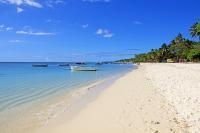
The beaches of Mauritius are close to perfect, with fine white sand and clear water running to heavenly shades of blue. Some of the island's best beaches, on the west coast, are easily reached from Port Louis. Flic en Flac is the longest beach in Mauritius and features a beautiful lagoon. Grand Baie, 12 miles (20km) to the north of the capital, is a major tourist centre, offering watersports, shops, nightlife, and restaurants to complement its splendid beach and deep sheltered bay. Also on the north coast road is Pereybere, one of the island's favoured swimming spots. Close to Pereybere visitors can find the gorgeous little beach, La Cuvette, which is a weekend favourite with locals. The Baie du Tamarin is at the mouth of the Tamarin River, in a beautiful setting, and is popular for surfing, with Indian Ocean rollers washing the beach all year round. In the southwest is Le Morne Brabant, characterised by a basaltic outcrop and beaches shaded by casuarinas and coconut trees. Snorkellers enjoy Trou-aux-Biches which has shallow waters and coral reefs. On the peaceful east coast of the island you'll find Constance Belle Mare Plage, a long stretch of beach which is ideal for watching sunrises and sunsets. Another east coast favourite is Roche Noires, named for the dramatic black volcanic rocks that line the water. The east coast is great for sailing.
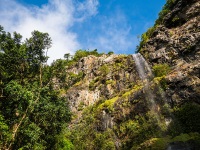
Situated in the southwest of the island, the Black River Gorges National Park is a popular spot for picnics, hiking and scenic drives. The park encompasses thick pine forests, gorges and rugged mountains and is a sanctuary for local flora and fauna. In fact, the park protects much of the island's remaining rainforest and some of Mauritius's endemic species, including the Mauritian flying fox. Bird-watchers will love the park and should look out for the Mauritius kestrel, the green echo parakeet and the Mauritius cuckoo shrike. The park's Chamarel Waterfalls are the highest in Mauritius at 83m (270ft) and are best seen after heavy rains. The best viewpoints are at the Alexandria Falls or the Black River Gorges viewpoint. Cars cannot enter much of the park, which has been designed primarily for walkers, with 37 miles (60km) of hiking trails. Cars can be safely left in the car park though. Trails vary in length and difficulty and there are two visitor centres where tourists can get maps and advice. There are usually souvenir and snack stands at the popular viewing points, but the best way to enjoy the park is to come prepared with a packed picnic and enjoy one of the lovely picnic spots.
Address : B103 - Plaine Champagne Road, Mauritius
Website : www.mauritiusattractions.com/hiking-trip-black-river-gorges-park-half-p-115.html
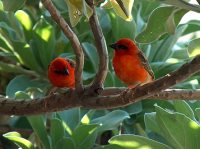
Home to nearly 150 species of birds, including ostriches and flamingos, Casela Park is a paradise for birdwatching in Mauritius. The park opened in 1979, and is home to many other kinds of animals as well, including zebras, giant tortoises, lions, monkeys, cheetahs, tigers, and various antelope. There are several different ways to explore the 14-hectare grounds of Casela, and visitors will enjoy exciting modes of transportation like ziplines, segways, quad bikes, and hanging bridges. The park is very family-friendly and there are programmes for kids and teenagers, as well as a petting farm and restaurant. Kids will love being able to hand feed animals and pet them and the whole family can enjoy game safaris. The park is perhaps most celebrated for its big cats and going walking with lions or petting a cheetah is indeed a once in a lifetime experience; sometimes there are even cubs to meet and cuddle. Some of the animals are kept in cages, but those visitors who disapprove of animals kept in captivity can avoid this section and still enjoy safaris to see the animals that roam the territory. The park appeals to people of all ages and it can easily keep visitors occupied for a full day of fun.
Address : Royal Road, Cascavelle
Website : www.caselapark.com/en/
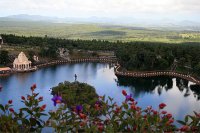
Located in a secluded mountain area in the district of Savanne, and bordering a national park, Ganga Talao (or Grand Bassin) is a crater lake considered to be the most sacred Hindu site in Mauritius. According to legend, Lord Shiva and his wife Parvati were travelling over Mauritius carrying the Ganges River, and a few drops spilled and formed Ganga Talao. On the shores of the lake is a temple dedicated to Shiva, and a number of other shrines, and every year many Hindus from around Mauritius make a pilgrimage to the site, often walking barefoot from wherever they live. One of the main sights at Ganga Talao is the 108-foot (33m) statue of Lord Shiva in the middle of the lake which is the tallest statue on the island, and an exact replica of the Shiva statue of Sursagar Lake in Vadodara, Gujarat, India. The lake, deep in the heart of Mauritius, is a popular attraction and has become quite commercial, with plenty of stalls selling souvenirs and snacks. It is nestled in a picturesque mountainous area and is well worth a stop if you are in the region. Be careful of the monkeys who are resident around the lake and temple; although they provide visitors with endless entertainment they are also liable to steal anything you leave unattended.
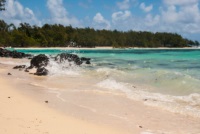
The small island of Ile aux Cerfs (Stag Island), off the east coast of Mauritius, is one of the country's most popular tourist destinations, managed by the adjacent Touessrok Hotel, but open to the public. The island, featuring splendid tropical vegetation and encircled by magnificent sandy beaches, can be reached by boat from the small fishing village of Trou d'eau Douce. The boat trip only takes about 15 minutes. The island is equipped with a number of bars, restaurant, and shops, as well as watersports facilities including parasailing, waterskiing, windsurfing, and glass bottomed boat trips. There is also a coral reef and lagoon which are perfect for snorkelling. The recent, and somewhat controversial, development on the island is an 18-hole Bernhard Langer designed championship golf course, which affords a sea view from each hole and promises the novelty of hitting a tee-shot over a natural sea inlet onto the fairway. Although there are many activities on offer, it is also possible to just wander along the idyllic beaches and enjoy sunbathing, swimming, and picnicking. The beach near the landing jetty is usually quite crowded but a short stroll will reveal more secluded slices of paradise.
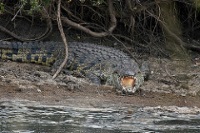
La Vanille Reserve des Mascareigne is a nature reserve in the unspoilt south of Mauritius, best known for its thousands of crocodiles and giant tortoises, which they are helping reintroduce to the island of Rodrigues. Reptiles in the park include Nile crocodiles, iguanas, caimans, geckos, chameleons, and tortoises, and there are also monkeys, bats, mongooses, wild boars, and some domestic farm animals for children to meet. The park boasts a huge population of butterflies and an insectarium as well. Many of the animals are kept in enclosures and cages, making it more of a zoo than a nature reserve, but the animals seem well cared for and the breeding programmes are for conservation purposes. The enormous tortoises, which roam freely, are a highlight, and kids can ride and feed them. The vegetation in the park is lush and there is some interesting flora to investigate, and plenty of shade. Guides are available to show visitors around and give information on the various animals. There is a children's playground area, a shop selling souvenirs (including crocodile skin products), and a restaurant which serves crocodile steak, among other things. La Vanille Reserve des Mascareigne is a wonderful attraction for families visiting Mauritius.
Address : Riviere des Anguilles
Website : www.lavanille-reserve.com/index.php/en/
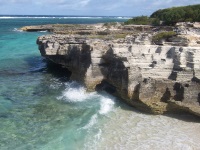
Sometimes called the 'Cinderella of the Mascarenes', Rodrigues is a tiny island roughly 348 miles (560km) east of Mauritius, and a popular excursion from there. The island is volcanic in origin and is surrounded by stunning coral reef; there are some even smaller, uninhabited islands off the coast. The reef that fringes Rodrigues forms a calm lagoon, which shelters the inlets and beaches of the island and creates wonderful conditions for swimming and snorkelling. There are some glorious little beaches to lounge on. Less touristy than the resort towns of Mauritius, Rodrigues Island offers visitors a glimpse of a simpler and more authentic way of life. The island itself is scenic, with unspoiled flora and fauna offering good opportunities for bird-watching, hiking, fishing, and exploring the wonderful caves. It is the only island in the archipelago that has extensive limestone deposits and caves. Rodrigues has a unique environment and a number of endemic species, including the critically endangered Rodrigues flying fox. Although it was once a district of Mauritius, Rodrigues became an autonomous region of Mauritius in 2002. The best way to get to Rodrigues Island is by plane from Port Louis to Plaine Corail Airport.
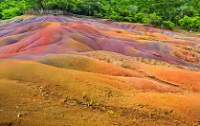
Promoted as Mauritius' first attraction back in the 1960s and located on the island of Chamarel, the Seven Coloured Earth is a magical sight and still quite a mysterious phenomenon. The Seven Coloured Earth is a geological formation of sand dunes comprised of seven distinct colours which give the rolling dunes a fantastical, psychedelic look. The colours are usually defined as red, brown, violet, green, blue, purple, and yellow. These warm colours are all the more striking in contrast to the bright green of the surrounding forest. The dunes are also interesting in that they never seem to erode, despite the tropical storms which lash the region. The sands have formed from the decomposition of volcanic rock and the colours can be traced back to certain mineral deposits and varying stages of decomposition, but the phenomenon that keeps the vivid colours so resolutely separate is still not completely understood. Visitors can no longer climb on the dunes, which are now protected by a wooden fence and ringed by a wooden boardwalk. The estate which houses the sands is full of lovely lush vegetation and there are some dramatic waterfalls to check out nearby. You can buy test tubes of the colourful sand at a number of gift shops and stalls in the area. Visitors should note that the weather and time of day plays a role in how dramatic the colours look - they often look best at sunrise.
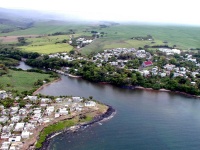
The small seaside resort of Souillac is situated along the rugged coast in the southern Savanne district. The appeal of Souillac lies in its scenery, as it is not a bathing spot. In striking contrast to the soft curves of the northern coastline, the high cliffs here drop abruptly to the sea to face the bracing winds of the Indian Ocean, which seem to blows all year round. The dramatic Gris-Gris cliffs are constantly smashed by waves (they are called the weeping cliffs - Roche qui Pleure - as a result) and tourists flock to the area to enjoy the rugged coastline. Souillac developed around, and was named after, the port built by the French, which gave the area strategic importance. Later, the English also relied heavily upon the port for the transport of trade goods, but after the introduction of railways to the island, in about 1877, the port gradually went into decline. Places of interest in Souillac for tourists include the Telfair Garden, which is wonderful for picnics, the old port area, the Gris-Gris cliffs, and the beautiful Rochester Falls. There are some great restaurants in the town and good accommodation for visitors. Souillac is special because it allows visitors to experience a different, wilder side of Mauritius.

Travel Guide powered by Word Travels, copyright © 2023 Globe Media Ltd. By its very nature information in this travel guide is subject to change at short notice and travellers are urged to verify information on which they're relying with the relevant authorities. Neither Globe Media Ltd nor Travel Vogue can accept any responsibility for any loss or inconvenience to any person as a result of information contained above.